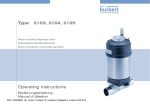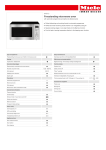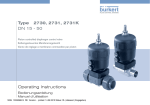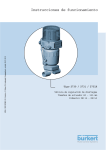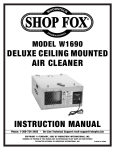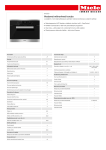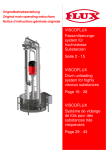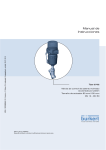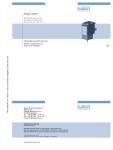Download Operating Instructions Type 2730, 2731, 2731K DN 15 - 50
Transcript
Type 2730, 2731, 2731K DN 15 - 50 Piston controlled diaphragm control valve Kolbengesteuertes Membranregelventil Vanne de réglage à membrane commandée par piston Operating Instructions Bedienungsanleitung Manuel d‘utilisation We reserve the right to make technical changes without notice. Technische Änderungen vorbehalten. Sous réserve de modifications techniques. © 2000 - 2014 Bürkert Werke GmbH Operating Instructions 1509/14_EU-ML_00803906 / Original DE Type 2730, 2731 and 2731K 1 Operating instructions.................................................................4 1.1 Symbols........................................................................................ 4 1.2 Definition of term “device”........................................................ 4 2 Authorized use.......................................................................................5 2.1 Restrictions.................................................................................. 5 3 Basic safety instructions...........................................................5 4 General information.........................................................................6 4.1 Contact address......................................................................... 6 4.2 Warranty....................................................................................... 6 4.3 Information on the internet....................................................... 6 5 Product description.........................................................................7 5.1 General description................................................................... 7 5.2 Properties..................................................................................... 7 5.3 Structure and function.............................................................. 7 6 Technical data.........................................................................................8 6.1 Conformity.................................................................................... 8 6.2 Standards..................................................................................... 8 6.3 Type label..................................................................................... 8 6.4 Labeling of the forged bodies................................................. 9 6.5 Operating conditions................................................................. 9 6.6 Flow values and characteristics............................................16 6.7 General technical data............................................................16 7 Installation............................................................................................. 17 7.1 Before installation.....................................................................17 7.2 7.3 Installation..................................................................................18 Pneumatic connection.............................................................19 8 Removal....................................................................................................... 20 9 Electrical control unit............................................................. 21 10 Malfunctions......................................................................................... 21 11 Maintenance............................................................................................ 22 11.1 Maintenance and cleaning.....................................................22 11.2 Replacing the diaphragm.......................................................23 12 Replacement parts........................................................................... 26 12.1 Order table.................................................................................26 13 Packaging, transport, storage........................................... 27 english 3 Type 2730, 2731 and 2731K Operating instructions 1 Operating instructions The operating instructions describe the entire life cycle of the device. Keep these instructions in a location which is easily accessible to every user and make these instructions available to every new owner of the device. The operating instructions contain important safety information. Failure to observe these instructions may result in hazardous situations. ▶▶ The operating instructions must be read and understood. 1.1 Caution! Warns of a possible danger. ▶▶ Failure to observe this warning may result in a moderately severe or minor injury. Note! Warns of damage to property. ▶▶ Failure to observe the warning may result in damage to the device or the equipment. Indicates important additional information, tips and recommendations. Symbols Danger! Refers to information in these operating instructions or in other documentation. Warns of an immediate danger. ▶▶ Failure to observe the warning may result in a fatal or serious injury. ▶▶ designates instructions for risk prevention. →→designates a procedure which you must carry out. Warning! Warns of a potentially dangerous situation. ▶▶ Failure to observe the warning may result in serious injuries or death. 4 english 1.2 Definition of term “device” The term “device” used in these instructions always stands for the diaphragm control valve Type 2730, 2731 and 2731K. Type 2730, 2731 and 2731K Authorized use 2 Authorized use Non-authorized use of the diaphragm control valve Type 2730, 2731 and 2731K may be a hazard to people, nearby equipment and the environment. ▶▶ The device is designed for the controlled flow of liquid media. ▶▶ The admissible data, the operating conditions and conditions of use specified in the contract documents, operating instructions and on the label are to be observed during use. The designated application cases are specified in the chapter entitled “5 Product description”. ▶▶ The device may be used only in conjunction with third-party devices and components recommended and authorised by Bürkert. ▶▶ Correct transportation, correct storage and installation and careful use and maintenance are essential for reliable and faultless operation. ▶▶ In the potentially explosion-risk area Type 2730, 2731 and 2731K may be used only according to the specification on the separate Ex type label. For use observe the additional information enclosed with the device together with safety instructions for the explosionrisk area. ▶▶ Devices without a separate Ex type label may not be used in a potentially explosive area. ▶▶ Use the device only as intended. 2.1 Restrictions 3 Basic safety instructions These safety instructions do not make allowance for any • contingencies and events which may arise during the installation, operation and maintenance of the devices. • local safety regulations, whereby the operator is responsible for their compliance, by the installation personnel too. Danger! Danger – high pressure. ▶▶ Before dismounting the lines and valves, turn off the pressure and vent the lines. Risk of electric shock. ▶▶ Before reaching into the device, switch off the power supply and secure to prevent reactivation. ▶▶ Observe applicable accident prevention and safety regulations for electrical equipment. Risk of injury when opening the actuator. The actuator contains a tensioned spring. If the actuator is opened, there is a risk of injury from the spring jumping out! ▶▶ The actuator must not be opened. Risk of burns. The surface of the device may become hot during long-term operation. ▶▶ Do not touch the device with bare hands. If exporting the system or device, observe any existing restrictions. english 5 Type 2730, 2731 and 2731K General information General hazardous situations. To prevent injury, ensure that: ▶▶ The system cannot be activated unintentionally. ▶▶ Installation and repair work may be carried out by authorized technicians only and with the appropriate tools. ▶▶ After an interruption in the power supply or pneumatic supply, ensure that the process is restarted in a defined or controlled manner. ▶▶ The device may be operated only when in perfect condition and in consideration of the operating instructions. ▶▶ The general rules of technology apply to application planning and operation of the device. To prevent damage to property on the device, ensure: ▶▶ Supply the media connections only with those media which are specified as flow media in the chapter entitled “6 Technical data”. ▶▶ Do not put any loads on the valve (e.g. by placing objects on it or standing on it). ▶▶ Do not make any external modifications to the valves. Do not paint the body parts or screws. The diaphragm control valve Type 2730, 2731 and 2731K was developed with due consideration given to accepted safety rules and is state-of-the-art. Nevertheless, dangerous situations may occur. 4 General information 4.1 Contact address Germany Bürkert Fluid Control Systems Sales Center Christian-Bürkert-Str. 13-17 D-74653 Ingelfingen Tel.: + 49 (0)7940 - 10 91 111 Fax: + 49 (0)7940 - 10 91 448 E-mail: [email protected] International Contact addresses are found on the final pages of the printed operating manual. You can also find information on the Internet under: www.burkert.com 4.2 Warranty The warranty is only valid if the device is used as authorized in accordance with the specified application conditions. 4.3 Information on the internet The operating instructions and data sheets for Type 2730, 2731 and 2731K can be found on the Internet at: www.burkert.com 6 english Type 2730, 2731 and 2731K Product description 5 Product description 5.2.1 5.1 General description The piston-controlled diaphragm control valve is available for the following actuator sizes: Device versions Actuator sizes The piston-controlled diaphragm control valve Type 2730, 2731 and 2731K is suitable for liquid media. Using neutral gases or air (control media), it controls the flow of dirty, aggressive, ultrapure or sterile media, even highly viscous media can be used (flow media). The operation of the diaphragm control valve Type 2730, 2731 and 2731K is possible only in combination with an control unit. Possible control units are: ø 80 mm, ø 100 mm, ø 125 mm. Pilot pressure Designs with lower pilot pressure (reduced spring force) are available on request. Contact your Bürkert sales office or our Sales Center, e-mail: [email protected] Positioner Type 8635, 8692, 8694, 8792 Process controller Type 8693, 8793 5.2 Properties • Any flow direction. • Self-draining for appropriate installation. The ends of the utilized connections must be cylindrical. • Free of empty space. 5.3 Structure and function The operation of the diaphragm control valve Type 2730, 2731 and 2731K is possible only in combination with an control unit. Possible control units are: Positioner Type 8635, 8692, 8694, 8792 Process controller Type 8693, 8793 • Low-turbulence flow. • High flow values by the streamlined valve body. 5.3.1 Structure • Maintenance-free under normal conditions. The piston-controlled diaphragm control valve consists of a pneumatically operated piston actuator and a 2/2-way valve body. english 7 Type 2730, 2731 and 2731K Technical data Actuator body Upper pilot air port Lower pilot air port Diaphragm socket Diaphragm Line connection Diaphragm body Fig. 1: 5.3.2 Structure and description Function / control functions (CF) Technical data 6.1 Conformity In accordance with the EC Declaration of conformity, the diaphragm control valve Type 2730, 2731 and 2731K is compliant with the EC Directives. 6.2 The applied standards, which verify conformity with the EC Directives, can be found on the EC-Type Examination Certificate and / or the EC Declaration of Conformity. 6.3 Normally closed by spring action 8 Sealing material 2731 A 25,0 EPDM VA D29 Pmed 10 bar Pilot 5,5-7 bar Body material Line connection / Permitted medium pressure Permitted pilot pressure 00148320 W14UN Date of manufacture Identification number Fig. 2: english Orifice (diaphragm size) Type Control function A (CFA) Normally open by spring action Type label Control function Spring force (CFA) or pneumatic pilot pressure (CFB) generates the closing force on the diaphragm pressure piece. The force is transferred via a spindle which is connected to the actuator piston. Control function B (CFB) Standards Made in Germany Actuator cover 6 Type label (example) Type 2730, 2731 and 2731K Technical data 6.4 Labeling of the forged bodies Batch number XX F XXXXXXXX/XXX 1.4435/316L(VS) XXXX PN16/CWP150 XXXXXX XXXXXXXXXX Material Production number / serial number Surface quality code Customer-specific text (optional) 6.5 Actuator size ø 80 mm Actuator material Environment 1) ø 100 mm PA, PPS -10 – +60 °C ø 125 mm Tab. 1: Permitted ambient temperature actuators 1) lastic body: note that the permissible medium pressure is P dependent on the medium temperature (see “Fig. 4: Graph of medium pressure / medium temperature”). Operating conditions Risk of injury, chemical burns, scalding due to the device rupturing at excessively high pressure. ▶▶ Do not exceed the maximum pilot and medium pressure. ▶▶ Observe permitted ambient and medium temperature. ▶▶ Observe specifications on the type label. If using a pilot valve / control unit, observe its temperature range. Permitted medium temperature for body Labeling of the forged bodies Warning! Temperature ranges Permitted ambient temperature actuators Nominal pressure Orifice connection and pipe dimension Fig. 3: 6.5.1 Body material Medium PVDF (PD) -10 – +120 °C PP (PP) -10 – +80 °C PVC (PV) -10 – +60 °C Stainless steel body (VA) 1.4404 (AISI 316L) Cast body (VG) 1.4435 (AISI 316L) Forged body (VS) 1.4435 BN2 (AISI 316L) according to ASME BPE 1997 -10 – +150 °C Tab. 2: Permitted medium temperature for body english 9 Type 2730, 2731 and 2731K Technical data Permitted medium temperature for diaphragms he indicated medium temperatures apply only to media T which do not corrode or swell the diaphragm materials. 6.5.2 Pilot pressure for valves with pneumatic position controller To ensure reliable operation with pneumatic position controller, observe the permitted minimum and maximum pilot pressure! The behavior of the medium with respect to the diaphragm may be changed by the medium temperature. The function properties, in particular the service life of the diaphragm, may deteriorate if the medium temperature increases. Actuator size [mm] Pilot pressure Do not use the diaphragms as steam shut-off element. ø 80, ø 100, ø 125 5.5 – 7.0 bar Material Temperature EPDM (AB) -10...+130 °C EPDM (AD) -5...+143 °C Remarks Steam sterilisation up to +140 °C / 60 min Steam sterilisation up to +150 °C / 60 min FKM (FF) 0...+130 °C No steam / dry heat up to +150 °C / 60 min PTFE (EA) -10...+130 °C Steam sterilisation up to +140 °C / 60 min Advanced PTFE (EU) -5...+143 °C Steam sterilisation up to +150 °C / 60 min Advanced PTFE (ET) -10...+90 °C - Gylon (ER) -5...+130 °C Steam sterilisation up to +140 °C / 60 min Tab. 3: Permitted medium temperature for diaphragms 10 Pressure ranges english Tab. 4: Pilot pressure for valves with pneumatic position controller Maximum pilot pressure for valves without pneumatic position controller Actuator size [mm] Actuator material Max. permitted pilot pressure2) ø 80, ø 100 PA 10 bar ø 125 PA 7 bar ø 80, ø 100, ø 125 PPS 7 bar Tab. 5: Maximum pilot pressure for valves without pneumatic position controller Type 2730, 2731 and 2731K Technical data Maximum pilot pressure for valves without pneumatic position controller - only control function B and stainless steel body (VA) Operating pressure for control function A3) The values apply to Actuator size [mm] Actuator material Max. permitted pilot pressure2) • Plastic body PVDF (PD), PP (PP), PVC (PV) ø 80, ø 100, ø 125 6 bar • Precision casting body (VG) Medium pressure for plastic body lastic body: note that the permissible medium pressure is P dependent on the medium temperature (see “Fig. 4”). Fig. 4: 8 DF 4 2 0 20 40 60 Max. sealed medium pressure [bar] Pressure on one Pressure on both side sides EPDM/FKM PTFE EPDM/FKM 15 10 10 10 ø 80 20 10 10 10 25 10 7.5 8.5 ø 100 32 10 8 9 40 10 10 10 ø 125 50 8 7 7 Tab. 7: Operating pressure for control function A PV 6 C PV Medium pressure [bar] 10 Orifice DN (Diaphragm size) [mm] bserve the maximum pressure range according to the type O label! 2) • Stainless steel body (VA) withISO weld end connection ISO clamp connection Threaded connection Welded neck flange Actuator size [mm] PA, PPS Tab. 6: Maximum pilot pressure for valves without pneumatic position controller - only CFB and stainless steel body (VA) • Forged steel body (VS) PP 80 Medium temperature [°C] 100 120 PTFE 10 10 5.5 6 9 6 140 Graph of medium pressure / medium temperature english 11 Type 2730, 2731 and 2731K Technical data • Stainless steel body (VA) withOD weld end connection BS clamp connection Max. sealed medium pressure [bar] Pressure on one Pressure on both side sides EPDM/FKM PTFE EPDM/FKM 15 10 10 10 20 10 10 10 ø 80 25 10 10 10 32 10 8 7.5 ø 100 40 10 8 8 ø 125 50 10 10 10 Tab. 8: Operating pressure for control function A 3) he control functions are described in the chapter entitled “5.3.2 T Function / control functions (CF)”. 12 english PTFE 10 10 9 6 6 8.5 Orifice DN (Diaphragm size) [mm] The values apply to • Stainless steel body (VA) withDIN weld end connection DIN clamp connection Actuator size [mm] The values apply to Orifice DN (Diaphragm size) [mm] Operating pressure for control function A3) Actuator size [mm] Operating pressure for control function A3) Max. sealed medium pressure [bar] Pressure on one Pressure on both side sides EPDM/FKM PTFE EPDM/FKM 20 10 10 10 25 10 10 10 ø 100 40 10 8 8 ø 125 50 10 10 10 Tab. 9: Operating pressure for control function A ø 80 PTFE 10 9 6 8.5 Type 2730, 2731 and 2731K The values in the following graphs apply to: • Plastic body PVDF (PD), PP (PP), PVC (PV) • Forged steel body (VS) • Precision casting body (VG) • Stainless steel body (VA) withISO- weld end connection ISO clamp connection Threaded connection Welded neck flange To protect the diaphragm during control function B, preferably do not select the pilot pressure higher than is required to switch the medium pressure. Fig. 5: 0 1 2 3 4 5 Pilot pressure [bar] 1 2 3 4 5 Pilot pressure [bar] DN50 6 7 8 ø 80, ø 100, ø 125 PTFE 6 7 8 P ressure graph, actuator ø 80 mm, control function B, elastomer diaphragm Fig. 7: 10 9 8 7 6 5 4 3 2 1 0 DN40 DN32 DN15 DN20 DN25 Control function B / PTFE diaphragm DN20 10 9 8 7 6 5 4 3 2 1 0 0 P ressure graph, actuator ø 100 mm and ø 125 mm, control function B, elastomer diaphragm Medium pressure [bar] Medium pressure [bar] ø 80 EPDM DN15 DN25 Control function B / elastomer diaphragm Fig. 6: 10 9 8 7 6 5 4 3 2 1 0 DN32 ø 100, ø 125 EPDM Medium pressure [bar] Required minimum pilot pressure depending on medium pressure for control function B. DN40 Technical data DN50 0 1 2 3 4 5 Pilot pressure [bar] 6 7 8 P ressure graph, actuator ø 80 mm, ø 100 mm and ø 125 mm, control function B, PTFE diaphragm english 13 Type 2730, 2731 and 2731K ø 100, ø 125 EPDM To protect the diaphragm during control function B, preferably do not select the pilot pressure higher than is required to switch the medium pressure. Fig. 8: DN25 Fig. 9: 0 1 2 3 4 5 Pilot pressure [bar] 6 7 P ressure graph, actuator ø 100 mm and ø 125 mm, control function B, elastomer diaphragm Control function B / PTFE diaphragm ø 80, ø 100, ø 125 PTFE 0 1 2 3 4 5 Pilot pressure [bar] 6 7 8 Pressure graph, actuator ø 80 mm, control function B, elastomer diaphragm 10 9 8 7 6 5 4 3 2 1 0 0 1 2 3 4 5 Pilot pressure [bar] 6 7 Fig. 10: P ressure graph, actuator ø 80 mm, ø 100 mm and ø 125 mm, control function B, PTFE diaphragm 14 8 DN50 DN40 DN15 DN20 DN25 DN32 10 9 8 7 6 5 4 3 2 1 0 Medium pressure [bar] Medium pressure [bar] ø 80 EPDM DN15 DN20 DN32 Control function B / elastomer diaphragm 10 9 8 7 6 5 4 3 2 1 0 DN40 • Stainless steel body (VA) withDIN weld end connection DIN clamp connection Medium pressure [bar] The values in the following graphs apply to: DN50 Technical data english 8 Type 2730, 2731 and 2731K To protect the diaphragm during control function B, preferably do not select the pilot pressure higher than is required to switch the medium pressure. Control function B / elastomer diaphragm 10 9 8 7 6 5 4 3 2 1 0 0 1 2 3 4 5 Pilot pressure [bar] 6 7 8 Fig. 12: Pressure graph, actuator ø 100 mm and ø 125 mm, control function B, elastomer diaphragm DN20 DN25 Control function B / PTFE diaphragm ø 80, ø 100, ø 125 PTFE 0 1 2 3 4 5 Pilot pressure [bar] 6 7 8 Fig. 11: Pressure graph, actuator ø 80 mm, control function B, elastomer diaphragm 10 9 8 7 6 5 4 3 2 1 0 0 1 2 3 4 5 Pilot pressure [bar] DN50 DN40 DN20 DN25 10 9 8 7 6 5 4 3 2 1 0 Medium pressure [bar] Medium pressure [bar] ø 80 EPDM ø 100, ø 125 EPDM DN40 • Stainless steel body (VA) withOD weld end connection BS clamp connection Medium pressure [bar] The values in the following graphs apply to: DN50 Technical data 6 7 8 Fig. 13: Pressure graph, actuator ø 80 mm, ø 100 mm und ø 125 mm, control function B, PTFE diaphragm english 15 Type 2730, 2731 and 2731K Technical data 6.6 Flow values and characteristics Flow values and characteristics for Types 2730 / 2731 / 2731K you find on Internet. 6.7 General technical data Actuator sizesø 80 mm, ø 100 mm, ø 125 mm Connections Pilot air portG1/4, stainless steel Line connection Type 2730 Socket and spigot DiaphragmEPDM in food quality, PTFE/EPDM, FKM Media Control mediumNeutral gases, air Quality classes in accordance with DIN ISO 8573-1 Dust content Class 5:max. particle size 40 μm, max. particle density 10 mg/m³ Water content Class 3:max. pressure dew point - 20 °C or min. 10 °C below the lowest operating temperature Type 2731 / 2731KWeld end: in accordance with EN ISO 1127 (ISO 4200), DIN 11850 R2 other connections on request Oil content Materials Type 2730Liquids; aggressive or abrasive media Body Type 2730PVDF (PD), PP (PP), PVC (PV) Type 2731 / 2731KLiquids; ultrapure, sterile, aggressive or abrasive media Type 2731 Stainless steel precision casting (VG) 1.4435 (AISI 316L), Stainless steel forged steel (VS) 1.4435 (AISI 316L) Installation positionany position, preferably with the actuator face up Type 2731KStainless steel body (VA) cold-formed 1.4404 (316L) Actuator PA, PPS Sealing elements actuator FKM, NBR 16 english Class 5:max. 25 mg/m³ with TopControl maxi 1 mg/m³ with SideControl Flow media Viscosity up to viscous Protection classIP67 in accordance with IEC 529 / EN 60529 Type 2730, 2731 and 2731K Installation 7 Installation Danger! Danger – high pressure in the equipment. ▶▶ Before loosening the lines and valves, turn off the pressure and vent the lines. Warning! Risk of injury from improper installation. ▶▶ Installation may be carried out by authorised technicians only and with the appropriate tools! Risk of injury from unintentional activation of the system and an uncontrolled restart. ▶▶ Secure system from unintentional activation. ▶▶ Following assembly, ensure a controlled restart. 7.1 Installation for leakage detection One of the bores (in the actuator base) for monitoring leakage must be at the lowest point. 7.1.2 Installation position 2/2-way valve The piston-controlled diaphragm control valve can be installed in any installation position, preferably with the actuator face up. To ensure self-drainage: →→Install body inclined by an angle α = 15° – 35° to the horizontal. →→Observe an inclination angle of 1° – 5° to the line axis. Forged and cast body: Mark on the body must point upwards (12 o’clock position, see “Fig. 14”). →→One of the bores (in the actuator base) for monitoring leakage must be at the lowest point. Mark α Before installation • Before connecting the valve, ensure the pipelines are flush. • The flow direction is optional. 7.1.1 Installation position general Angle α: 15 °– 35° Inclination to the line axis 1° – 5° Fig. 14: Installation position for self-drainage of the body Installation for self-drainage of the body It is the responsibility of the installer and operator to ensure self-drainage. english 17 Type 2730, 2731 and 2731K Installation 7.1.3 Preparatory work →→Clean pipelines (sealing material, swarf, etc.). →→Support and align pipelines. Devices with VG/VS/VA welded body: Note! Damage to the diaphragm or the actuator! ▶▶ Before welding in the body, remove the actuator. Remove the actuator from the valve body: Note! Damage to the diaphragm or the seat contour! ▶▶ When removing the actuator, ensure that the valve is in open position. →→Control function A pressurize the lower pilot air port with com- pressed air (5 bar): valve opens. →→Remove actuator with diaphragm by loosening the body screws. 7.2 Installation Warning! Risk of injury from improper installation. Non-observance of the tightening torque is dangerous as the device may be damaged. ▶▶ Observe the tightening torque (see “Tab. 10: Tightening torques for diaphragms”). 7.2.1 Installation of the valve body Welded bodies →→Weld valve body in pipeline system. Other body versions →→Connect body to pipeline. 7.2.2 Installation of the actuator (welded body) Installation for actuator with control function A: Notice! Actuator Upper pilot air port Lower pilot air port Diaphragm Body screws (4x) Valve body Fig. 15: Installation 18 english Damage to the diaphragm or the seat contour! ▶▶ When installing the actuator, ensure that the valve is in open position. →→Control function A pressurize the lower pilot air port with compressed air (5 bar): valve opens. →→Lightly cross-tighten the body screws until the diaphragm is between the body and actuator. Do not tighten the screws yet. →→Actuate the diaphragm control valve twice. Type 2730, 2731 and 2731K Installation →→Without pressurization tighten the body screws to the permitted tightening torque (see following table “Tab. 10: Tightening torques for diaphragms”). Installation for actuator with control functions B: →→Lightly cross-tighten the body screws without pressurization until the diaphragm is between the body and actuator. Do not tighten the screws yet. →→Pressurize upper pilot air port of the actuator with compressed air (5 bar). →→Actuate the diaphragm control valve twice. →→With pressurization tighten the body screws to the permitted tightening torque (see “Tab. 10: Tightening torques for diaphragms”). Orifice DN (diaphragm size) Tightening torques for diaphragms [Nm] EPDM PTFE 15 3.5 4 20 4 4.5 25 5 6 32 6 8 40 8 10 50 12 15 Tab. 10: Tightening torques for diaphragms 7.3 Pneumatic connection DANGER! Danger – high pressure in the equipment. ▶▶ Before loosening the lines and valves, turn off the pressure and vent the lines. Warning! Risk of injury from unsuitable connection hoses. Hoses which cannot withstand the pressure and temperature range may result in hazardous situations. ▶▶ Use only hoses which are authorised for the indicated pressure and temperature range. ▶▶ Observe the data sheet specifications from the hose manufacturers. The operation of the diaphragm control valve Type 2730, 2731 and 2731K is possible only in combination with an control unit. Possible control units are: Positioner Type 8635, 8692, 8694, 8792 Process controller Type 8693, 8793 Observe the type label! The pneumatic connection of the control unit is described in the respective operating instructions for the control unit. english 19 Type 2730, 2731 and 2731K Removal 7.3.1 Connection of the actuator 8 DANGER! Control functions A: →→Connect the control medium to the lower pilot air port of the actuator (see “Fig. 16: Pneumatic connection”) Control functions B: →→Connect the control medium to the upper pilot air port of the actuator (see “Fig. 16: Pneumatic connection”) Silencer For reducing the exhaust air noise: plug the silencer into the free air discharge connection (see “Fig. 16: Pneumatic connection”) If used in an aggressive environment, we recommend conveying all free pneumatic connections into a neutral atmosphere with the aid of a pneumatic hose. Upper pilot air port Lower pilot air port Fig. 16: Pneumatic connection Control air hose: Control air hoses of sizes 6/4 mm or 1/4“ can be used. 20 Removal english Risk of injury from discharge of medium and pressure. It is dangerous to remove a device which is under pressure due to the sudden release of pressure or discharge of medium. ▶▶ Before removing a device, switch off the pressure and vent the lines. Procedure: →→Loosen the pneumatic connection. →→Remove the device. Note! Deformation of the diaphragm! ▶▶ For prolonged storage of the valves, slacken the housing screws. Type 2730, 2731 and 2731K Electrical control unit 9 Electrical control unit The valve Type 2730, 2731 and 2731K can be combined with following control units: 10 Malfunctions Malfunction Cause /remedial action Actuator does not switch Pilot air port interchanged4) CFA: Connecting lower pilot air port • Type 8692Positioner TopControl CFB: Connecting upper pilot air port • Type 8694Positioner TopControl Basic Pilot pressure too low See pressure specifications on the type label. • Type 8635 Positioner SideControl • Type 8792 Positioner SideControl • Type 8693 Process controller TopControl • Type 8793 Process controller SideControl Medium pressure too high See pressure specifications on the type label. Valve is not sealed Medium pressure too high See pressure specifications on the type label. Pilot pressure too low See pressure specifications on the type label. The electrical connection of the control unit is described in the respective operating instructions for the control unit. Flow rate reduced PTFE diaphragm bulging →→Replace diaphragm. Tab. 11: Malfunctions 4) see “Fig. 16: Pneumatic connection” english 21 Type 2730, 2731 and 2731K Maintenance 11 Maintenance DANGER! 11.1.2 Wearing parts of the diaphragm control valve Parts which are subject to natural wear: Danger – high pressure in the equipment. ▶▶ Before loosening the lines and valves, turn off the pressure and vent the lines. Risk of injury due to electrical shock. ▶▶ Before reaching into the system, switch off the power supply and secure to prevent reactivation! ▶▶ Observe applicable accident prevention and safety regulations for electrical equipment! • Seals • Diaphragm →→If leaks occur, replace the particular wearing part with an appropriate spare part (see chapter “12 Replacement parts”). A bulging PTFE diaphragm may reduce the flow. The replacing of the wearing parts is described in chapter “11.2”. Warning! Risk of injury from improper maintenance. ▶▶ Installation may be carried out by authorized technicians only and with the appropriate tools! Risk of injury from unintentional activation of the system and an uncontrolled restart. ▶▶ Secure system from unintentional activation. ▶▶ Following maintenance, ensure a controlled restart. 11.1 Maintenance and cleaning 11.1.3 Inspection intervals →→Check diaphragm for wear after maximum 105 switching cycles. Muddy and abrasive media require correspondingly shorter inspection intervals! 11.1.4 Service life of the diaphragm The service life of the diaphragm depends on the following factors: 11.1.1 Actuator • Diaphragm material The actuator of the diaphragm control valve is maintenance-free provided it is used according to these operating instructions. • Medium, Medium pressure, Medium temperature 22 english • Actuator size Type 2730, 2731 and 2731K Maintenance • Pilot pressure for CFB. Protecting the diaphragm →→For CFA match the actuator size (actuator force) to the medium pressure to be actuated. If required, select the actuator with reduced spring force EC04. →→For CFB try and select the pilot pressure not higher than is required to actuate the medium pressure. 11.1.5 Cleaning Commercially available cleaning agents can be used to clean the outside. Note! Avoid causing damage with cleaning agents. ▶▶ Before cleaning, check that the cleaning agents are compatible with the body materials and seals. 11.2 Replacing the diaphragm DANGER! Risk of injury from discharge of medium and pressure. It is dangerous to remove a device which is under pressure due to the sudden release of pressure or discharge of medium. ▶▶ Before removing a device, switch off the pressure and vent the lines. Fastening types Orifice (Diaphragm size) [mm] 15 20 25 40 50 Fastening types for diaphragms PTFE EPDM / FKM Diaphragm with bayonet catch Diaphragm with bayonet catch Diaphragm with bayonet catch Diaphragm screwed in Tab. 12: Fastening types for diaphragms english 23 Type 2730, 2731 and 2731K Maintenance Replacement for control function A →→Clamp the valve body in a holding device (applies only to valves not yet installed). Marker flap of the diaphragm Notice! Damage to the diaphragm or the seat contour! ▶▶ When removing the actuator, ensure that the valve is in open position. Actuator Upper pilot air port →→Pressurize lower pilot air port of the actuator with compressed Lower pilot air port air (5 bar): valve opens. Diaphragm →→Loosen the four body screws. →→Remove the actuator from the body. →→Unbutton or unscrew old diaphragm. If attachment is with a bayonet catch, remove the diaphragm by rotating it through 90°. For orifice DN25-DN50 observe chapter “11.2.1”. →→Install new diaphragm. →→Align diaphragm. Body screws (4x) Valve body Fig. 17: Repairs Replacement for control functions B →→Clamp the valve body in a holding device. The marker flap of the diaphragm must be perpendicular to the direction of flow (see “Fig. 17”)! (applies only to valves not yet installed). →→Place actuator back on the body. →→Insert the body screws and lightly cross-tighten until the dia- →→Loosen the four body screws. →→Remove the actuator from the body. →→Unbutton or unscrew old diaphragm. If attachment is with a →→Actuate the diaphragm control valve twice. →→Without pressurization tighten the body screws to the per- →→Install new diaphragm. →→Align diaphragm. phragm is between the body and actuator. Do not tighten the screws yet. mitted tightening torque (see “Tab. 13: Tightening torques for diaphragms”). 24 english bayonet catch, remove the diaphragm by rotating it through 90°. For orifice DN25-DN50 observe chapter “11.2.1”. The marker flap of the diaphragm must be perpendicular to the direction of flow (see “Fig. 17”)! Type 2730, 2731 and 2731K Maintenance →→Place actuator back on the body. →→Lightly cross-tighten the body screws without pressurization until the diaphragm is between the body and actuator. Do not tighten screws yet. Orifice DN15 and DN20: →→Pressurize upper pilot air port of the actuator with compressed air (5 bar) (see “Fig. 17”). →→Actuate the diaphragm control valve twice. →→With pressurization tighten the body screws to the per- mitted tightening torque (see “Tab. 13: Tightening torques for diaphragms”). Orifice DN (diaphragm size) 11.2.1 Switch between PTFE and EPDM diaphragms →→Loosen PTFE diaphragm bayonet and attach new EPDM diaphragm. Orifice DN25 up to DN50: →→Loosen PTFE diaphragm bayonet. →→Place the insert in the pressure piece. →→Insert and screw in EPDM diaphragm. Tightening torques for diaphragms [Nm] EPDM PTFE 15 3.5 4 20 4 4.5 25 5 6 32 6 8 40 8 10 50 12 Tab. 13: Tightening torques for diaphragms 15 english 25 Type 2730, 2731 and 2731K Replacement parts 12 Replacement parts 12.1 Order table Risk of injury and/or damage by the use of incorrect parts! Orifice (Diaphragm size) [mm] Incorrect accessories and unsuitable replacement parts may cause injuries and damage the device and the surrounding area. ▶▶ Use only original accessories and original replacement parts from Bürkert. 15 677 664 E02** 688 422 E03** 677 685 F01** 15 BC** 693 162 E02** 693 163 E03** 693 164 F01** F01** Caution! The diaphragm is available as a replacement part for the piston-controlled diaphragm control valve Type 2730, 2731 and 2731K. If you have any queries, please contact your Bürkert sales office. Order numbers for diaphragms EPDM (AB*) Fig. 18: Diaphragm replacement part 26 english FKM (FF*) 20 677 665 E02** 688 423 E03** 677 686 20 BC** 693 165 E02** 693 166 E03** 693 167 F01** 25 677 667 E01** 688 424 E03** 677 687 F01** 32 677 668 E01** 688 425 E03** 677 688 F01** 40 677 669 E01** 688 426 E03** 677 689 F01** 50 677 670 E01** 688 427 E03** 677 690 F01** PTFE (EA*) Diaphragm EPDM (AD*) Advanced PTFE (EU*) Laminated advanced PTFE (ET*) 15 677 675 E02PTFE** 679 541 E02PTFE+ Hole** 677 695 L02** 20 677 676 E02PTFE** 679 542 E02PTFE+ Hole** 677 696 L02** 25 677 677 E02PTFE** 679 543 E02PTFE+ Hole** 677 697 L01** Type 2730, 2731 and 2731K Packaging, transport, storage 32 677 678 E02PTFE** 679 544 E02PTFE+ Hole** – 40 677 679 E02PTFE** 679 545 E02PTFE+ Hole** 677 698 E02PTFE** 679 546 E02PTFE+ Hole** 677 699 50 677 680 Tab. 14: Order numbers for diaphragms * SAP Code ** Identification on the diaphragm 13 L01** Packaging, transport, storage Note! Transport damages! L01** Inadequately protected equipment may be damaged during transport. • During transportation protect the device against wet and dirt in shock-resistant packaging. • Avoid exceeding or dropping below the permitted storage temperature. Incorrect storage may damage the device. • Store the device in a dry and dust-free location! • Storage temperature -20 – +65 °C. Damage to the environment caused by device components contaminated with media. ▶▶ Dispose of the device and packaging in an environmentally friendly manner. ▶▶ Observe applicable regulations on disposal and the environment. Note: Observe national waste disposal regulations. english 27 www.burkert.com





























